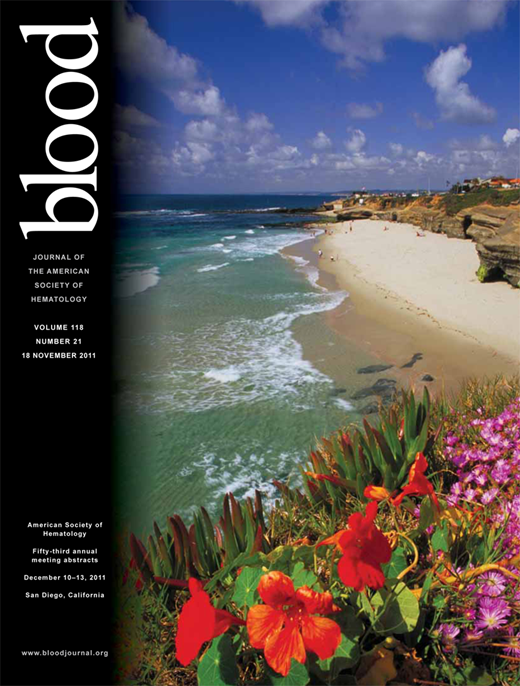Abstract
Abstract 2975
IL-10 is a key immune-regulatory cytokine and its gene polymorphisms correlate with severity of clinical graft-versus-host (GVHD). IL-10 is made by a variety of donor and host cells, but the functional relevance of its source in acute GVHD is not well understood. We utilized well characterized MHC matched, minor mismatched C3H.SW →B6 model of acute GVHD to first examine the relevance host hematopoietic derived IL-10 on acute GVHD induced by alloreactive donor T effector cells in the absence of donor regulatory T (Tregs) cells. We generated [WTB6→B6-Ly5.2] and [IL-10−/−B6→B6-Ly5.2] chimeras such that only the host hematopoietic derived cells were incapable of producing IL-10 and utilized them as recipients. The chimeras were lethally irradiated and transplanted with 5×106 T cell-depleted (TCD) BM and 2×105 CD8+ T cells from either the allogeneic C3H.SWor the syngeneic B6 donors. All of the allogeneic animals demonstrated similar clinical severity and mortality from GVHD (65% vs 72%, P=NS). Because IL-10 can also be derived from non-hematopoietic cells, we next determined whether the absence of IL-10 secretion by both hematopoietic and non-hematopoietic cells would modulate GVHD severity. To this end, the WT B6 and the IL-10−/− B6 animals were irradiated with 10Gy and transplanted 5×106 T cell-depleted bone marrow (TCDBM) and 2×105 CD8+ T cells from either allogeneic C3H.SW or the syngeneic B6 donors. All of the allogeneic animals demonstrated similar severity and mortality from GVHD regardless of whether all of the host cells can make IL-10 (P=0.1, NS).
We next examined relevance of IL-10 deficiency in donor cells. 1×106 CD25+depleted donor T effectors from either WT or IL-10−/− B6 mice were infused along with 5×106 TCDBM from WT B6 into lethally irradiated allogeneic C3H.SW or syngeneic B6 animals. The allogeneic animals that received either WT or IL-10−/− B6 effector cells demonstrated similar GVHD severity and mortality (P=0.6). Further, when T effectors from WT B6 mice were infused along with TCDBM from either WT or IL-10−/− B6 donors, the allogeneic C3H.SW animals once again demonstrated similar GVHD mortality (70% vs 80%, P=NS). Thus deficiency of IL-10 in either host tissues or in the donor grafts did not alter CD25+ depleted donor T effector cell mediated severity of GVHD.
We next examined the relevance of the source of IL-10 in donor natural (Treg) mediated regulation of GVHD. Donor CD4+CD25+ Tregs from C3H.SW donors induced equivalent protection from GVHD mortality in both WT and IL-10−/− hosts (90% vs. 100%, P=NS). To examine the relevance of IL-10 derived from Tregs, we transplanted 0.25×106 CD4+CD25+ Tregs from either B6 or IL-10−/− donors along with 1×106 CD25 depleted T effectors (1 :4 ratio) into C3H.SW animals. 100% of the allogeneic animals that received WT donor Tregs survived while only 60% of those that receive IL-10−/− donor Tregs survived (P=0.001). However, when the Il-10−/− donor Treg numbers were increased to 1×106 (1 :1 ratio), all of the allogeneic animals survived (P=0.008) demonstrating that donor Treg derived IL-10 is not obligatory but is necessary for optimal reduction of GVHD.
To determine the role of donor BM derived IL-10 in Treg mediated protection from GVHD, Tregs and T effector cells from WT B6 donors (1 :4 ratio) were transplanted along with 5×106 TCD BM from either WT or IL-10−/− B6 donors into lethally irradiated allogeneic C3H.SW animals. The allogeneic recipients of WT BM were protected from GVHD mortality, donor Tregs failed to protect the allogeneic animals that received IL10−/− donor BM (85% vs. 20%, P<0.04) in whom the rate of mortality was similar to the animals that did not receive any donor Tregs (P=0.96). Mechanistic studies demonstrated that donor Tregs continued to express similar levels of foxp3 and expansion early (day 7) after BMT. However the their expansion was significantly reduced at later time-points (day 14 and 21) when the hosts received BM from IL-10−/− donors. Together these data suggest that IL-10 from either host or donors does not contribute to the induction of GVHD severity by the T effector cells. However, only donor BM and donor Treg derived IL-10 is important for donor Treg mediated suppression of GVHD.
No relevant conflicts of interest to declare.
Author notes
Asterisk with author names denotes non-ASH members.

